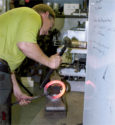Advertise Follow Us
Articles Tagged with ''shoeing''
Shoeing For A Living
Maryland farrier bases his hoof care on attention to bony column alignment and encouraging circulation
Read More
Power to the Shoer
The anvil and hammer still play a key role — but so do tools that are plugged in or run off batteries
Read More
Shoeing For A Living
Shoeing the High-Stepping Tennessee Walking Horse
Team approach lauded by farriers, trainer in preparing horses for the upcoming show season
Read More
Don't Let the Dogs Out!
Eliminating potential dangers before they lead to injuries comes with experience in horseshoeing
Read More
Product Focus
Watch Your Back
If your toolbox is not both farrier and horse friendly, it’s not doing the job you need it to do
Read More
Get it Done Vs. Get it Done Right
A horseman’s approach to training young horses for shoeing and trimming
Read More
Step On It!
High-tech pressure mat system gives this Texas veterinarian new information for evaluating and tailoring shoeing
Read More
Shoeing for the Trail
Horses who are used by their owners in shows as well as for pleasure can present a real challenge for farriers
Read More
Shoeing Only for One Client
After 39 years of shoeing, this Kentucky farrier now works only for one trainer, but it’s a role that has included handling the footwork on two Kentucky Derby winners
Read More













